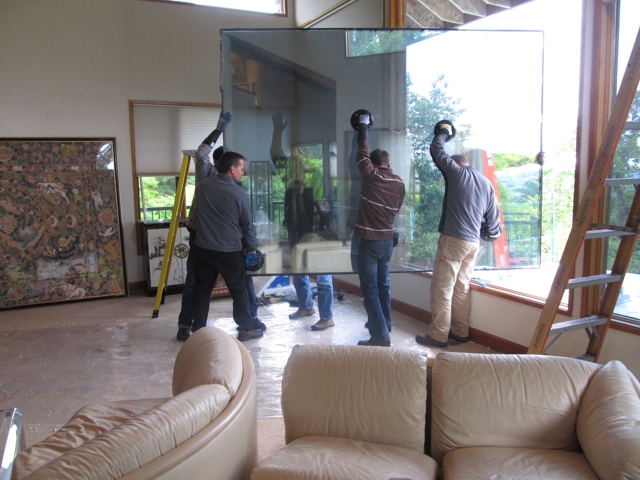|

Living on a hillside up above Southwest Mountain Road in West Linn, you might want to have huge windows to capitalize upon the view. Unfortunately, the center window somehow developed a crack just prior to our client putting their house on the market.
|

Fortunately, the builder of this house did think about these huge picture windows enough to have built a 3 foot wide CATWALK, if you will, on the exterior. Presumably, this was to provide a reasonable means for cleaning the windows. Jared & David are shown above removing the exterior stop material, while standing atop the catwalk, while others are building the scaffold platform & removing the front door assembly.
|

This CATWALK provided us enough additional space and support for us to erect our scaffold up to same level and to create a platform large enough for us pull the glass out to the exterior (the only way it would come) and to then lay the glass down flat, after which we tilted it back up upon the alternate axis.
|

This enabled us to lift the glass back up and carry it back into the house through the window opening via its narrower dimension. From this side of the house, it looks as though we are working up on the 2nd story, but that is actually a daylight basement below us. The window is actually on the main-floor relative to the front of the house.
|

This is of course a good thing, in that it ends up being pretty much a straight shot through the living room down a short hallway to the front door which leads out to the driveway at the front of the house.
|

Taking out the OLD. One of the dangers when handling large pieces of plate glass like this is that if the glass is set down upon the wrong sort of surface, it could break under its own weight. So we dare not set it down on the window sill while we wrestle it through the opening.
|

The new insulated glass unit is delivered to the job-site. Removal of the original insulated unit and installation of the new unit necessitated temporary removal of the entire front door & jamb assembly, and that is the door, sidelights, jamb and all!
|

Believe it or not, this was the most practical, safe and cost effective way to get the old and new glass transported from and to the opening. With the entire front door and sidelight assembly completely removed, we were able to tilt the glass at an angle and carry it through the rough-opening.
|

Putting in the NEW. To the uninitiated, it might be helpful to consider that this unit is actually two pieces of quarter inch thick glass (570.47 LBS). It took six of us to safely move this insulated glass unit
|